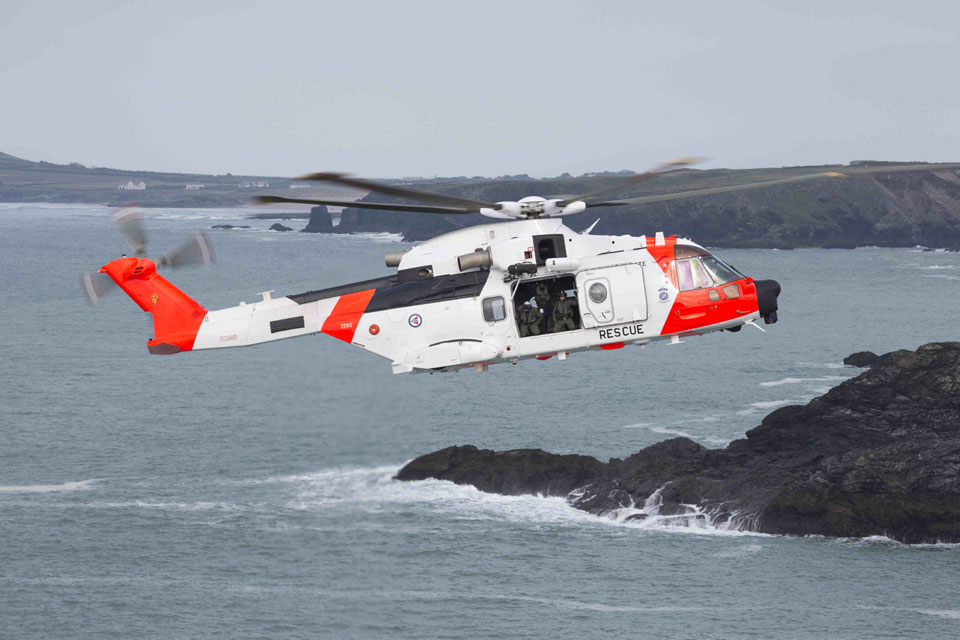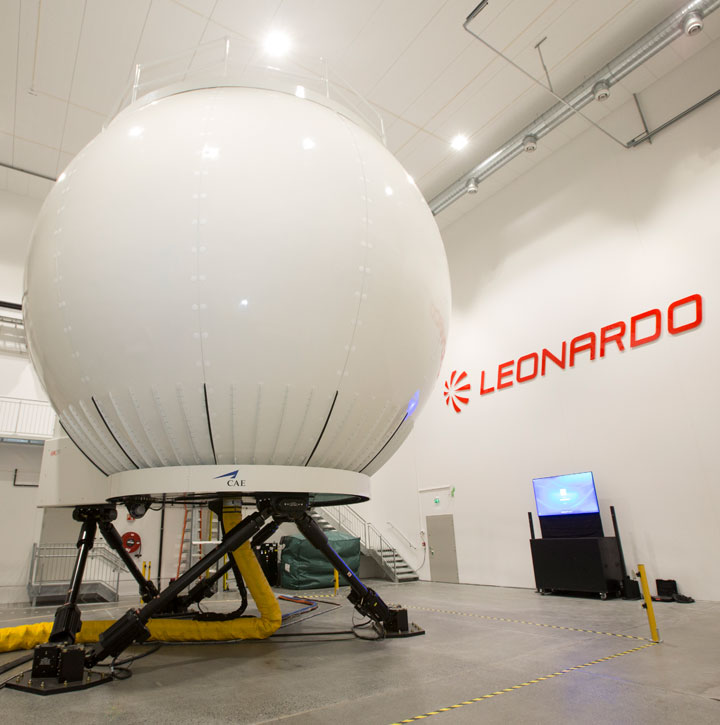As part of our series looking at Norway’s NAWSARH (AW101) programme, we have reviewed how Leonardo has delivered a truly advanced platform for the Norwegian Ministry of Justice and Public Security and the operator Royal Norwegian Air Force’s (RNoAF) 330 Squadron, and undoubtedly the most capable SAR platform in the world. Bristling with the latest avionics, sensor suites, and uprated engine performance, Leonardo has delivered a superb capability for Norway, but the company’s involvement does not stop at the helicopter delivery.
As part of the NAWSARH programme, Leonardo has implemented a comprehensive turnkey support and training package. The company is committed to a long-term collaboration with the Ministry of Justice and RNoAF, with the aim of cultivating their existing strong relationship and the ultimate objective of safeguarding lives throughout the vast Norwegian region of responsibility for Search and Rescue and Contra Terror. This integrated package will ensure that the advanced AW101 platform and their brave crews are ready and prepared for the challenging missions that 330 Squadron discharge on a daily basis.
Ensuring the AW101 is ready for the frontline
Leonardo plays an integral role in maintaining and supporting the RNoAF-operated fleet, with staff co-located with crews at each SAR base in Norway. Leonardo is responsible for performing all of the base maintenance of the aircraft, and the company also supports line maintenance activities when requested by the RNoAF. This includes the utilisation of Leonardo embedded technicians at each of the six bases across Norway to work under the direction of the RNoAF maintenance organisation, a truly collaborative approach maximising the advantages of military and industry personnel to achieve the required availability.

Leonardo also supports the logistical requirements for the aircraft, which includes modelling requirements, pre-provisioning to align with forecast consumption and scheduled activity together with all stores management across Norway. This ensures each base has the materiel it needs when it needs it. Leonardo personnel manage this activity throughout, with personnel co-located with the RNoAF, shortening the materiel ‘demand signal’ between operator and industry.
“We're able to engage directly with the vendors to ensure we've got the right parts, at the right time, and the right volumes to achieve the service required,” explained Mark Goddard, Senior Customer Support Manager - NAWSARH & Poland, Customer Support & Training.
As well as staff located at each base, Leonardo has a large team working with 330 Sq’s leadership supporting areas such as fleet management and planning, harmonising the decisions and actions across the bases to provide the maximum possible availability. Further to this engineering advice and support is provided directly to the Norwegian Material and Defence Agency (NDMA) Continuing Airworthiness Management Organisation (CAMO). This again shortens the ‘demand signal’ between operator and industry allowing effective and swift resolution of technical queries.
This industry-led support arrangement builds on Leonardo’s significant experience of Integrated Operational Support (IOS) for in-service helicopters around the world, including the majority of the UK’s military helicopter fleet such as the Merlin, Wildcat, and Apache helicopters.
This experience is critical when it comes to ensuring that SAR platforms remain serviceable and have high availability, which is a must for 330 Squadron’s mission where lives are at stake 24 hours a day, 365 days a year.
“Search and Rescue is a no-fail, it can’t afford to have a dip in service,” said Goddard. “By operating the way we do, we have introduced the AW101 into service in Norway and we have not skipped a heartbeat.”
Achieving 99% availability
As a testament to the hard work of the RNoAF and Leonardo team, the NAWSARH AW101 went into service and immediately achieved 99% availability, launching for all its missions. This trend has continued as each operating base has gone live and the AW101 has progressively taken over from the Sea King.
To help improve the availability and reliability of the platform further, the AW101 is a fully electronic aircraft with a full suite of health-usage monitoring systems (HUMS), which allows data to be downloaded from the aircraft after every sortie and examined by experts across the Leonardo business to understand how the aircraft and its components are performing.
“We're able to see what the cycle rate is, the flight hours, the engine starts, landings, how it's being flown, in-ground effect, out-of-ground effect, et cetera, which allows us then to inform our modelling and understand the reliability of the components,” explained Goddard.
Working with the OEM means this data can be shared across the company and allows design engineers to review the performance of specific components, which will ensure they are performing as intended and will influence further design updates in the future that all AW101 customers can benefit from.
AW101 training – building around automation
As well as benefiting from working directly with the OEM for operational support, Norway also benefits from using Leonardo as its training partner.
The AW101 is a complex platform with high levels of automation, and as crews have moved over from the SAR Queen’s predecessor, the venerable Sea King, it has been critical that crews are trained properly and that skills are developed early and maintained throughout their career.
“For the Sea King crews, we knew how much a step up it would be onto modern avionics and advanced automation,” said Richard Fox, Leonardo Helicopters UK’s Chief Flying Instructor. “This meant building all of the training around the automation, because this aircraft is all about the automation.”
Crews have to first go through a technical ground school, with training led by the RNoAF but with support from staff at Leonardo.
The Leonardo Norway Training Centre team also developed a “pre-sim” course with the aim of bridging the theoretical knowledge into an operational context, which would leverage unit-level training devices (ULTD) – touchscreen devices that replicate the AW101 cockpit and System Operator Console – to help crews use and manage the AW101’s advanced automation effectively.
Simulators at Leonardo’s Norway Training Centre
Personnel then move onto a full-motion, civil-compliant Level D Full Flight simulator located at the Norway Training Centre in Stavanger, Sola. This replicates the most up-to-date variant of the helicopter that Norway operates and is available for any global AW101 operator to use. Several of Leonardo’s customers are recognising the benefits of this facility and taking advantage, making the facility a busy but fundamental part of the company’s support and training arsenal.

Both the full-motion Level D simulator and ULTDs benefit from using the actual helicopter software, which means that flight crews will experience the same interfaces and controls, including the actual Automatic Flight Control System (AFCS).
“It’s not simulated, it’s the real aircraft software and that means that when they are training there is no degradation in the simulated model,” said Fox.
By partnering with the OEM, the actual aircraft avionics software is upgraded through an iterative approach with the RNoAF, and concurrently the simulators will also be upgraded, which is often not the case with third-party training providers.
Crews can also experience simulated sensor feeds that they would experience inside the real aircraft, including the platform’s advanced mobile phone locator system, which plays such a crucial role operationally.
From simulator training, crews will then go on to training on the live helicopter via the RNoAF’s Operational Training and Evaluation (OT&E) unit and run through a tactical qualification programme (TQP), which covers not only the remaining conversion to the helicopter, but also how to operate the helicopter in the SAR role, before then being deployed to their operational base.
Leonardo has not just played a key role in the technology, but has also developed and written the courseware that underpins the training of Norwegian crews. This included the first iteration of the conversion-to-type training, as well as 330 Sqn’s currency training (crews are required to pass this three times a year), where the Training Centre team helped to write the programme and mission scenarios.
Linking training with operational availability
The use of synthetic training devices is also closely linked with the availability and reliability of the platform, removing some of the requirement to train in the live environment on a real airframe. Approximately 1,400 hours are removed from the airframe as a result of this, which has a positive impact on platform availability and mission readiness.
Each base that operates the AW101 also has a unit-level training device (UTLD) that allows crews to self-study and run through scenarios and maintain proficiency on the avionics.
And it’s not just the flight crew that benefit from advanced training devices, ground crews such as maintainers also use synthetic training devices that ensure they meet their Part 66 requirements for currency.
Conclusion
Leonardo has been a close partner with Norway for over five decades and this partnership is growing even stronger and closer through the NAWSARH programme’s operational support and training activities. This long-term relationship combined with the innovative support and training solutions has many benefits for the Ministry of Justice and RNoAF. The turnkey solution ensures mission readiness, and allows Leonardo and its partners to build efficiencies, shortening the ‘demand signal’, investing for the long term, guaranteeing that the people of Norway will have a safe and highly reliable SAR / Contra Terror platform – and highly-proficient crew members – for many years to come.

